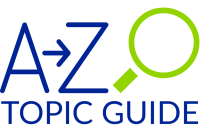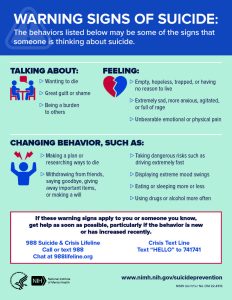Topic-Specific Resources Listed from A-Z
Suicide Prevention
The following article is from the National Institute of Mental Health (NIMH). While this material has been expert-reviewed, it is not NIMH or MHANYS intention to provide specific medical advice. Both MHANYS and NIMH advise readers to consult with a qualified health care provider for diagnosis, treatment, and answers to personal questions.
If You Know Someone in Crisis
Call or text the 988 Suicide & Crisis Lifeline at 988 (para ayuda en español, llame al 988). The Lifeline provides 24-hour, confidential support to anyone in suicidal crisis or emotional distress. Call 911 in life-threatening situations. If you are worried about a friend’s social media updates, you can contact safety teams at the social media company. They will reach out to connect the person with the help they need.
The Veterans Crisis Line connects Service members and Veterans in crisis, as well as their family members and friends, with qualified Department of Veteran’s Affairs (VA) responders through a confidential toll-free hotline, online chat, or text messaging service. Dial 1-800-273-8255 and Press 1 to talk to someone or send a text message to 838255 to connect with a VA responder. You can also start a confidential online chat session at Veterans Crisis Chat.
Introduction
Suicide is a major public health concern. In 2020, suicide was the 12th leading cause of death overall in the United States, claiming the lives of over 45,900 people. Suicide is complicated and tragic, but it is often preventable. Knowing the warning signs for suicide and how to get help can help save lives.
What is Suicide?
Suicide is when people harm themselves with the goal of ending their life, and they die as a result.
A suicide attempt is when people harm themselves with the goal of ending their life, but they do not die.
Avoid using terms such as “committing suicide,” “successful suicide,” or “failed suicide” when referring to suicide and suicide attempts, as these terms often carry negative meanings.
Warning Signs
Warning signs that someone may be at immediate risk for attempting suicide include:
- Talking about wanting to die or wanting to kill themselves
- Talking about feeling empty or hopeless or having no reason to live
- Talking about feeling trapped or feeling that there are no solutions
- Feeling unbearable emotional or physical pain
- Talking about being a burden to others
- Withdrawing from family and friends
- Giving away important possessions
- Saying goodbye to friends and family
- Putting affairs in order, such as making a will
- Taking great risks that could lead to death, such as driving extremely fast
- Talking or thinking about death often
Other serious warning signs that someone may be at risk for attempting suicide include:
- Displaying extreme mood swings, suddenly changing from very sad to very calm or happy
- Making a plan or looking for ways to kill themselves, such as searching for lethal methods online, stockpiling pills, or buying a gun
- Talking about feeling great guilt or shame
- Using alcohol or drugs more often
- Acting anxious or agitated
- Changing eating or sleeping habits
- Showing rage or talking about seeking revenge
It is important to note that suicide is not a normal response to stress. Suicidal thoughts or actions are a sign of extreme distress and should not be ignored. If these warning signs apply to you or someone you know, get help as soon as possible, particularly if the behavior is new or has increased recently.
Here are five steps you can take to #BeThe1To help someone in emotional pain:
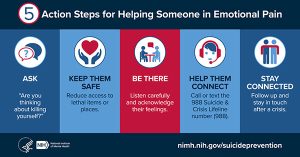
- ASK: “Are you thinking about killing yourself?” It’s not an easy question, but studies show that asking at-risk individuals if they are suicidal does not increase suicides or suicidal thoughts.
- KEEP THEM SAFE: Reducing a suicidal person’s access to highly lethal items or places is an important part of suicide prevention. While this is not always easy, asking if the at-risk person has a plan and removing or disabling the lethal means can make a difference.
- BE THERE: Listen carefully and learn what the individual is thinking and feeling. Research suggests acknowledging and talking about suicide may reduce rather than increase suicidal thoughts.
- HELP THEM CONNECT: Save the 988 Suicide & Crisis Lifeline number (call or text 988) and the Crisis Text Line number (741741) in your phone so they’re there if you need them. You can also help make a connection with a trusted individual like a family member, friend, spiritual advisor, or mental health professional.
- STAY CONNECTED: Staying in touch after a crisis or after being discharged from care can make a difference. Studies have shown the number of suicide deaths goes down when someone follows up with the at-risk person.
Risk Factors
Suicide does not discriminate. People of all genders, ages, and ethnicities can be at risk. Suicidal behavior is complex, and there is no single cause. The main risk factors for suicide are:
- Depression, other mental disorders, or substance use disorder
- Chronic pain
- A history of suicide attempts
- Family history of a mental disorder or substance use
- Family history of suicide
- Exposure to family violence, including physical or sexual abuse
- Presence of guns or other firearms in the home
- Having recently been released from prison or jail
- Exposure, either directly or indirectly, to others’ suicidal behavior, such as that of family members, peers, or celebrities
Most people who have risk factors will not attempt suicide, and it is difficult to tell who will act on suicidal thoughts. Although risk factors for suicide are important to keep in mind, someone who is showing warning signs of suicide may be at higher risk for danger and need immediate attention.
Stressful life events (such as the loss of a loved one, legal troubles, or financial difficulties) and interpersonal stressors (such as shame, harassment, bullying, discrimination, or relationship troubles) may contribute to suicide risk, especially when they occur along with suicide risk factors.
Family and friends are often the first to recognize the warning signs of suicide, and they can take the first step toward helping a loved one find mental health treatment.
Identifying People at Risk for Suicide
- Universal Screening: Research has shown that a three-question screening tool helps emergency room personnel identify adults at risk for suicide. Researchers found that screening all patients – regardless of the reason for their emergency room visit – doubled the number of patients identified as being at risk for suicide. The researchers estimated that suicide-risk screening tools could identify more than three million additional adults at risk for suicide each year.
- Predicting Suicide Risk Using Electronic Health Records: Researchers from NIMH partnered with the VA and others to develop computer programs that could help predict suicide risk among veterans receiving VA health care. Other healthcare systems are beginning to use data from electronic health records to help identify people with suicide risk as well.
Treatments and Therapies
Effective, evidence-based interventions are available to help people who are at risk for suicide.
Brief Interventions
- Safety Planning: Personalized safety planning has been shown to help reduce suicidal thoughts and actions. Patients work with a caregiver to develop a plan that describes ways to limit access to lethal means such as firearms, pills, or poisons. The plan also lists coping strategies and people and resources that can help in a crisis.
- Follow-up phone calls: Research has shown that when at-risk patients receive further screening, a Safety Plan intervention, and a series of supportive phone calls, their risk of suicide goes down.
Psychotherapies
Multiple types of psychosocial interventions have been found to help individuals who have attempted suicide (see below). These types of interventions may prevent someone from making another attempt.
- Cognitive Behavioral Therapy (CBT) can help people learn new ways of dealing with stressful experiences. CBT helps individuals recognize their thought patterns and consider alternative actions when thoughts of suicide arise.
- Dialectical Behavior Therapy (DBT) has been shown to reduce suicidal behavior in adolescents. DBT has also been shown to reduce the rate of suicide in adults with borderline personality disorder, a mental illness characterized by an ongoing pattern of varying moods, self-image, and behavior that often results in impulsive actions and problems in relationships. A therapist trained in DBT can help a person recognize when their feelings or actions are disruptive or unhealthy and teach the person skills that can help them cope more effectively with upsetting situations.
Medication
Some individuals at risk for suicide might benefit from medication. Health care providers and patients can work together to find the best medication or medication combination, as well as the right dose. Because many individuals at risk for suicide often have a mental illness or substance use problems, individuals might benefit from medication along with psychosocial intervention.
Clozapine is an antipsychotic medication used primarily to treat individuals with schizophrenia. To date, it is the only medication with a specific U.S. Food and Drug Administration (FDA) indication for reducing the risk of recurrent suicidal behavior in patients with schizophrenia or schizoaffective disorder.
If you are prescribed a medication, be sure you:
- Talk with your health care provider or a pharmacist to make sure you understand the risks and benefits of the medications you’re taking.
- Do not stop taking a medication without talking to your health care provider first. Suddenly stopping a medication may lead to “rebound” or worsening of symptoms. Other uncomfortable or potentially dangerous withdrawal effects also are possible.
- Report any concerns about side effects to your health care provider right away. You may need a change in the dose or a different medication.
- Report serious side effects to the FDA MedWatch Adverse Event Reporting program online or by phone at 1-800-332-1088. You or your health care provider may send a report.
For the most up-to-date information on medications, side effects, and warnings, visit the FDA website.
Collaborative Care
Collaborative Care is a team-based approach to mental health care. A behavioral health care manager will work with the person, their primary health care provider, and mental health specialists to develop a treatment plan. Collaborative care has been shown to be an effective way to treat depression and reduce suicidal thoughts.
Federal Resources
- The African American Youth Suicide: Report to Congress is a response by the U.S. Department of Health and Human Services that builds upon the 2019 Congressional Black Caucus report, “Ring the Alarm: The Crisis of Black Suicide in America.” The report examines patterns of youth suicide by race and ethnicity, what is known about youth suicide decedent characteristics, information on risk and protective factors, interventions, and remaining knowledge gaps.
- The Suicide Prevention Resource Center (SPRC) is the only federally supported resource center devoted to advancing the implementation of the National Strategy for Suicide Prevention. SPRC is funded by the Substance Abuse and Mental Health Services Administration (SAMHSA).
- The American Indian and Alaska Native (AI/AN) National Suicide Prevention Strategic Plan is a national initiative addressing suicide prevention, based on fostering collaborations across Tribes, Tribal organizations, Urban Indian organizations, and the Indian Health Service (IHS). The IHS Suicide Prevention and Care site provides resources to support suicide prevention efforts, and to help communities and individuals understand and obtain services related to suicide.
- The Center for Disease Control and Prevention’s (CDC) Suicide Prevention webpage provides resources for communities and states to support suicide prevention efforts.
- MedlinePlus offers information about suicide from the U.S. National Library of Medicine.
- National Action Alliance for Suicide Prevention is a public-private partnership working to advance the National Strategy for Suicide Prevention.
- The Surgeon General’s Call to Action to Implement the National Strategy for Suicide Prevention outlines the actions that communities and individuals can take to reduce the rates of suicide and help improve resilience.
- #BeThe1To is the National Suicide Prevention Lifeline’s message to spread the word about actions everyone can take to prevent suicide.
- Ask Suicide-Screening Questions (ASQ) is free screening resource for medical settings (e.g., emergency departments, inpatient medical/surgical units, outpatient clinics/primary care) that can help nurses or physicians successfully identify youth at risk for suicide.
Handouts
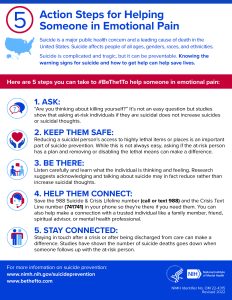 English / Español
English / Español 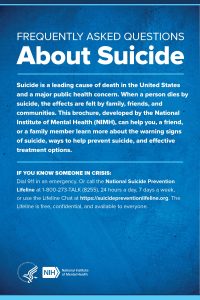 English / Español
English / Español
Mental Health Association in New York State (MHANYS) has additional resources that can be accessed through its main website. These resources include links to advocacy and policy work, school-based programs, mental health wellness training programs and more.
MHANYS
mhanys.org
Advocacy and Policy
mhanys.org/advocacy-policy
Mental Health Community Partners
mhcommunitypartners.org
CarePath™
mhanys.org/carepath
SMHRT: Family Education
https://www.mentalhealthednys.org/family-education-webinar-series/
Data Source
National Institute of Mental Health: Mental Health Information Health Topics www.nimh.nih.gov/health/topics
